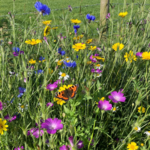
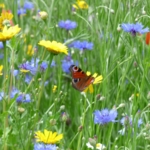
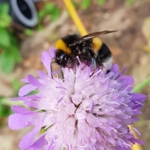
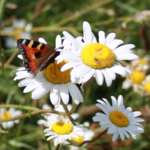
A rich variety of plants with high nectar to attract bees and other pollinators. Get back in touch with nature with our specially-crafted mix of wildflower seeds for bees and butterflies. Using only the most nectar and pollen-rich species, this collection is nothing short of a floral feast for our treasured pollinators, such as the buff-tailed bumblebee and red admiral butterfly.
Brimming with a diverse range of annual and perennial wildflower species, including dozens of the RHS’s recommended ‘Plants for Pollinators’ - there's no better way to get your garden buzzing with life!
Contains 22 different native wildflower species and 4 naturalised 'super-pollinators' for maximum benefit to bees and butterflies - borage, sainfoin, white clover and red clover.
Sowing Rate: 3 grams per sq/m - 1kg covers 330sq/m.
Check out the specification sheet for more details.
| Common Name | Latin Name | Quantity | Flowers | Height | Type | |
|---|---|---|---|---|---|---|
| 1 | Agrimony, Common | Agrimonia eupatoria | 1% | Jun - Sep | 50-150cm | Perennial |
| 2 | Borage | Borago officinalis | 7% | Aug-Sep | 60-80cm | Annual |
| 3 | Clary, Wild | Salvia verbenaca | 4% | May-Aug | 30-40cm | Perennial |
| 4 | Clover, Red | Trifolium pratense | 3% | May-Sep | 20-60cm | Perennial |
| 5 | Clover, White | Trifolium repens | 1% | Jun-Sep | 15-20cm | Perennial |
| 6 | Corn Cockle | Agrostemma githago | 8% | May-Aug | 50-70cm | Annual |
| 7 | Cornflower | Centaurea cyanus | 6% | Jun-Oct | 20-80cm | Annual |
| 8 | Daisy, Ox-eye | Leucanthemum vulgare | 5% | May-Sep | 20-100cm | Perennial |
| 9 | Foxglove, Wild | Digitalis purpurea | 3% | Jun-Aug | 50-100cm | Biennial |
| 10 | Knapweed, Common | Centaurea nigra | 6% | Jun-Sep | 30-80cm | Perennial |
| 11 | Knapweed, Greater | Centaurea scabiosa | 5% | Jun-Sep | 50-90cm | Perennial |
| 12 | Loosestrife, Purple | Lythrum salicaria | 1% | Jun-Sep | 100-200cm | Perennial |
| 13 | Marjoram, Wild | Origanum vulgare | 1% | Jul-Oct | 20-50cm | Perennial |
| 14 | Meadow Cranesbil | Geranium pratense | 1% | May-Aug | 40-60cm | Perennial |
| 15 | Musk Mallow | Malva moschata | 5% | May-Sep | 20-150cm | Perennial |
| 16 | Poppy, Common | Papaver rhoeas | 5% | May-Jul | 50-70cm | Annual |
| 17 | Ragged Robin | Lychnis flos-cuculi | 2% | May-Aug | 30-90cm | Perennial |
| 18 | Sainfoin | Onobrychis viciifolia | 7% | Jul-Sep | 30-40cm | Perennial |
| 19 | Scabious, Field | Knautia arvensis | 7% | Jul-Sep | 30-200cm | Perennial |
| 20 | Scabious, Small | Scabiosa columbaria | 3% | Jul-Aug | 20-60cm | Perennial |
| 21 | Teasel | Dipsacus fullonum | 1% | Jul-Aug | 100-200cm | Biennial |
| 22 | Trefoil, Bird's-foot | Lotus corniculatus | 2% | Jun-Aug | 10-40cm | Perennial |
| 23 | Vetch, Kidney | Anthyllis vulneraria | 2% | May-Oct | 15-50cm | Perennial |
| 24 | Viper's Bugloss | Echium vulgare | 2% | May-Oct | 50-100cm | Biennial |
| 25 | Yarrow | Achillea millefolium | 5% | Jun-Oct | 20-100cm | Perennial |
| 26 | Yellow Rattle | Rhinanthus minor | 7% | Jun-Sep | 20-50cm | Annual |
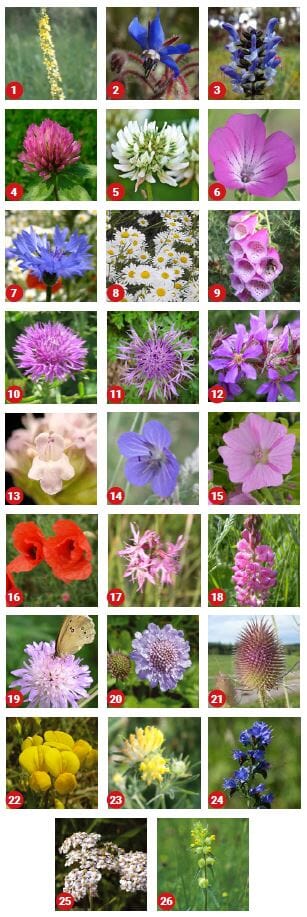
LWBP Butterfly & Bee Wildflower Seed Mix performs best in low nutrient soils, which haven’t been heavily fertilised in the past. For best results sow into bare soil after clearing all existing plants and weeds from the area. Cultivate the ground to a depth of 10cm to relieve compaction and create a fine level tilth, free from obstructions (to allow for mowing at a later stage). Finish the seedbed by treading or lightly rolling the area, so that it is firm enough to stand on without leaving indentations.
Where weeds have been prevalent, allow a flush of weeds to germinate and remove these before sowing. In areas of high fertility, it may be necessary to remove the topsoil and sow into the subsoil. High nutrient soils encourage weeds and fast growing grasses which may outcompete the wildflowers in this mixture. LWBP can be used to overseed into existing grassland, provided the sward comprises only fine leaved grasses and does not include ryegrass, agricultural species or weeds. Cut the grass as short as possible and thoroughly scarify or rake the ground to remove any thatch, moss and other debris from the area.
BSBP should be sown between March and November. Spring and autumn provide ideal conditions as moisture and warmth are in good supply. If overseeding into grass, it is best to sow during autumn when grass growth has slowed down.
Distribute seed with a handheld or pedestrian spreader, at the recommended sowing rate of 3g/sqm. Mix the wildflower seeds with an inert carrier (such as sharp sand), at a ratio of four parts sand to one part seed (by weight). This makes it easier to achieve an even distribution and also provides a visual marker, making it easier to see any missed patches and avoid seeding areas twice.
Regularly mix the seed when sowing, as seeds will naturally separate due to variations in size and weight.
Once sown, ensure good ‘seed to soil’ contact by lightly raking to a depth of 0.5cm or rolling the area. When overseeding this encourages the seeds to fall down to the ground underneath.
It is also possible to broadcast, drill or hydroseed this mixture for larger or hard to reach areas. However, broadcast spreading throws heavier seeds further so this may impact the distribution and when drilling, the seed must not be buried deeper than 0.7cm.
The sowing rate of 3g/sqm is designed to produce optimum results. Reducing the sowing rate is likely to result in invasion from weed species. Increasing the sowing rate generally leads to reduced diversity as the more aggressive species will outcompete slower growing plants.
This rate also applies when overseeding into grassland as many seeds may fail to germinate due to the increased competition from the existing grasses, and some seeds not reaching the soil surface.

Landlife Wildflowers grow and supply high-quality, native wildflower products, restoring wildflowers right across the UK. Working in conjunction with wildlife charity, Buglife, we’re bringing back Britain’s treasured wildflowers! Find out more about why we’ve been trusted by the general public, Natural England and The National Trust for over twenty years.

We’re proud to supply only the highest-quality, native wildflower products - tried, tested and refined by us for two decades to ensure each and every customer is delighted with their purchase. Find out more about our commitment to the supply of native, provenance-assured wildflower products to restore Britain’s natural wildflower habitats for bees, butterflies, birds and wildlife.

If you have any questions or would like to get in touch, our team of wildflower experts are on hand to guide you every step of the way. We love talking about wildflowers and the quality of our products, and are pleased to help with any enquiry, including how to establish wildflowers, product recommendations and even creating custom mixtures for specific projects.